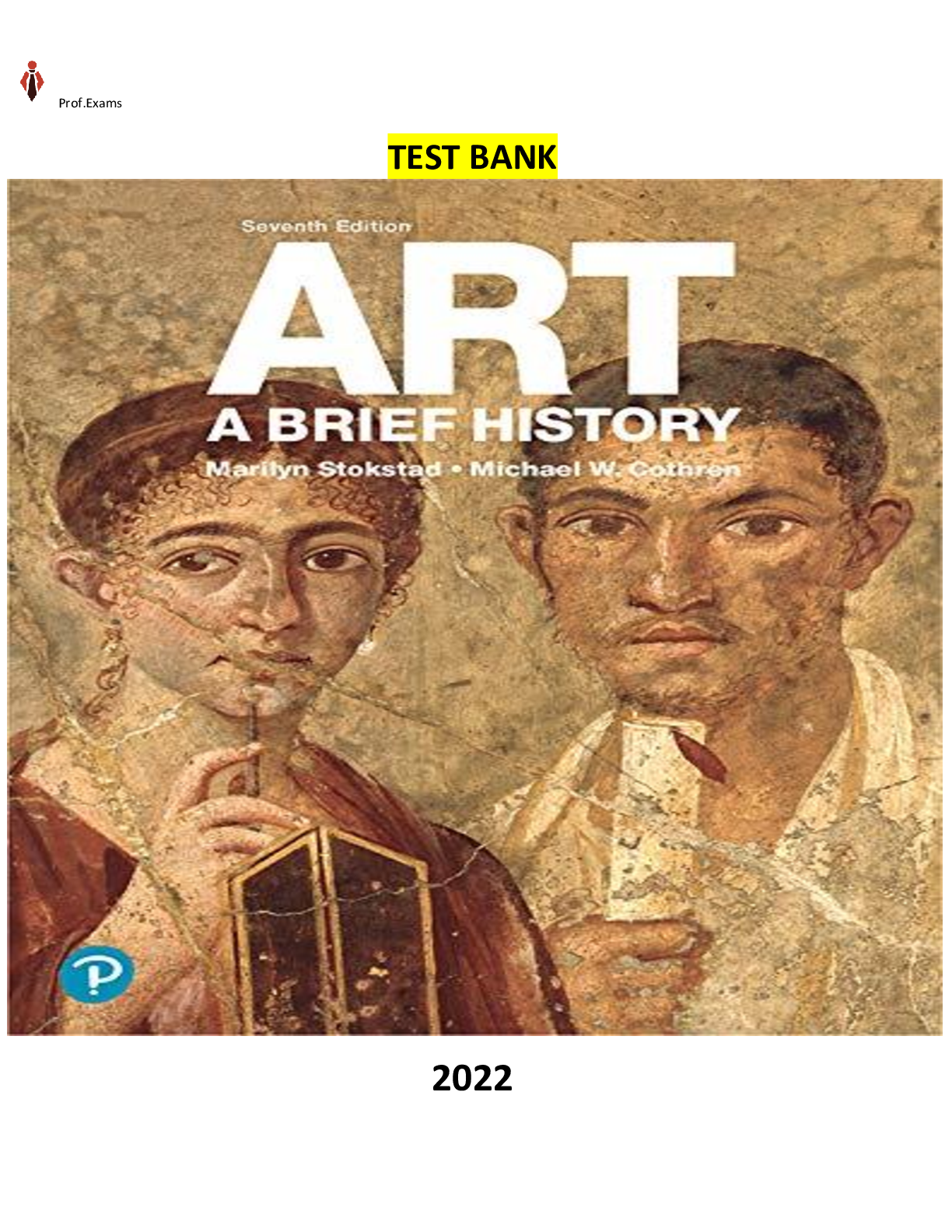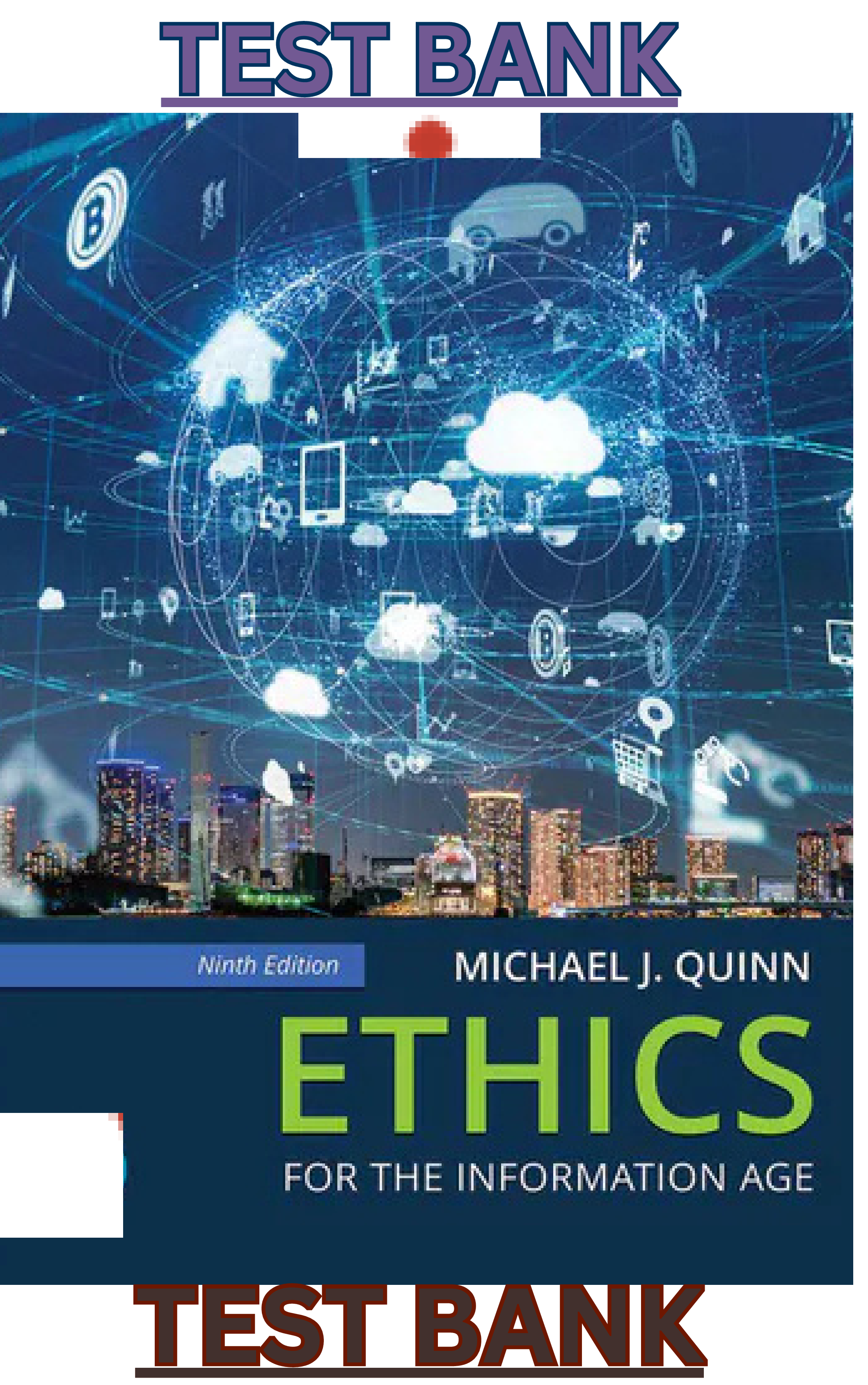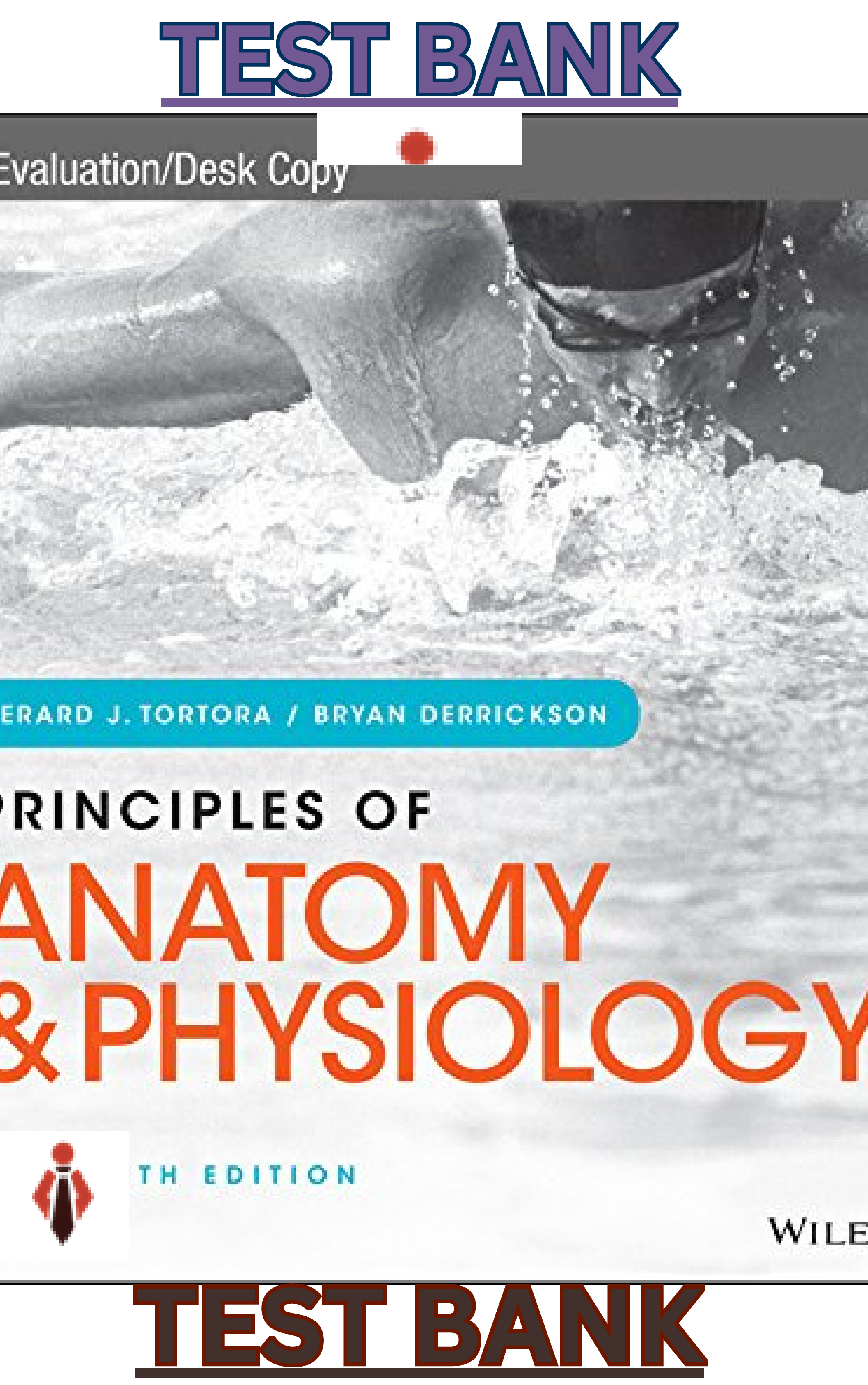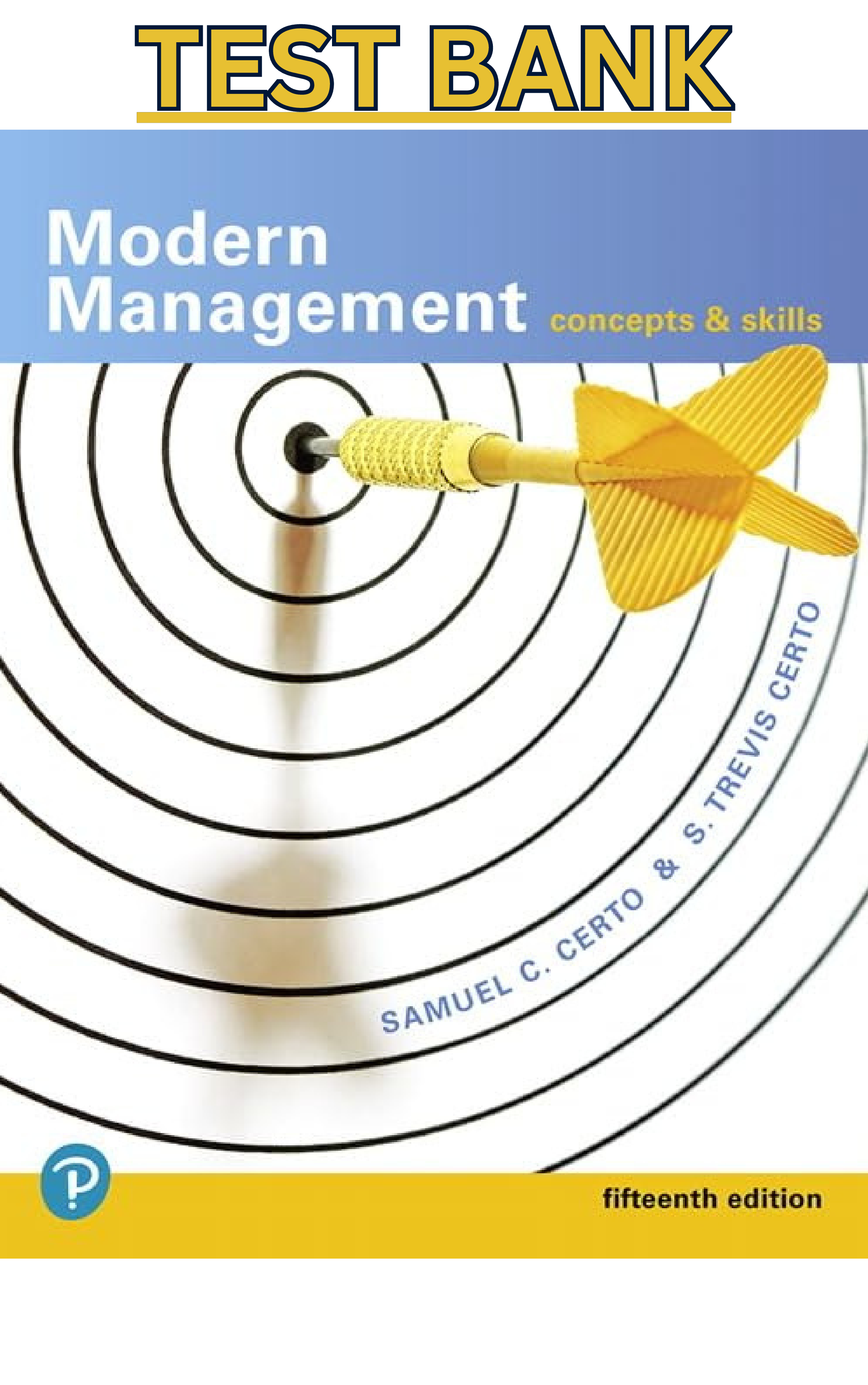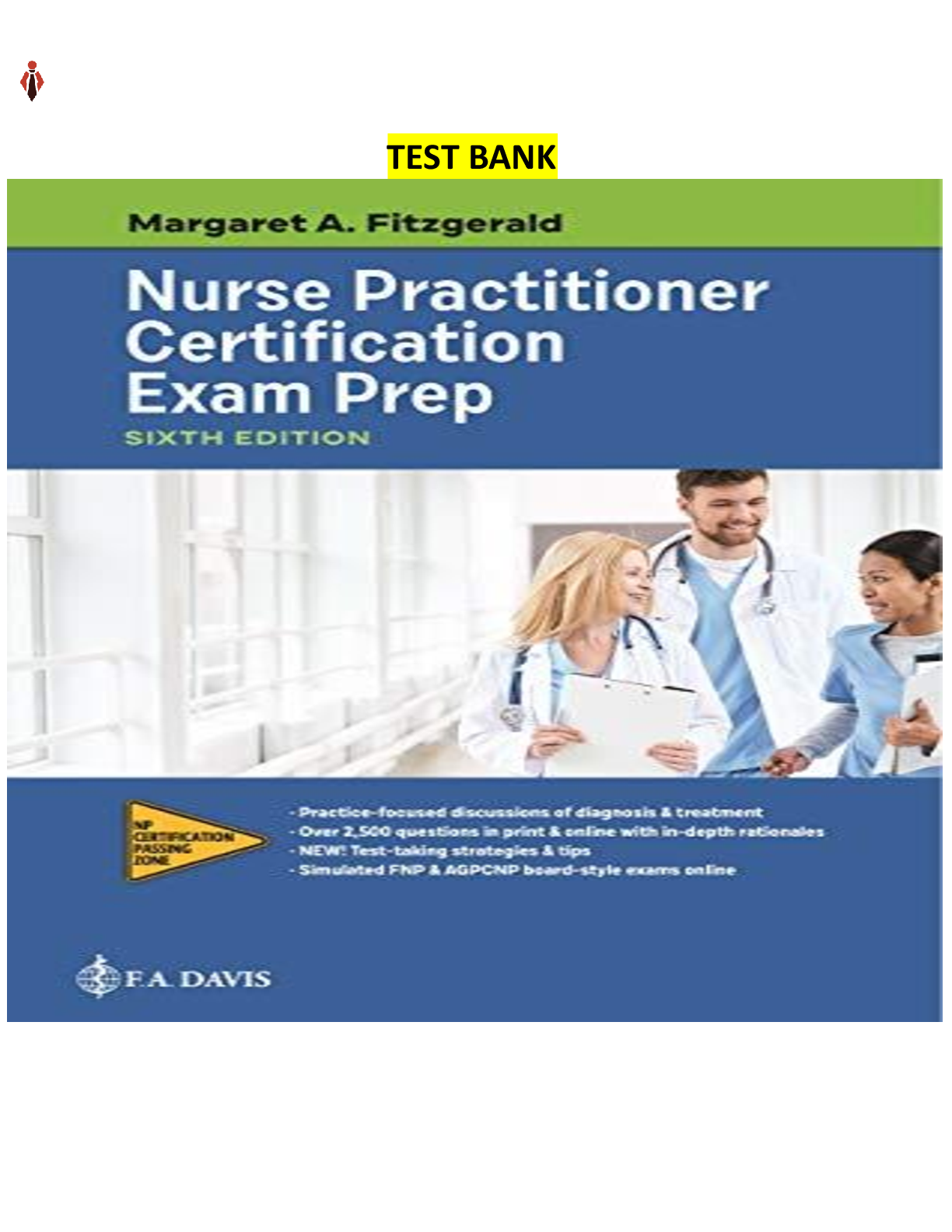Statistics > TEST BANKS > TEST BANK for Statistics-Informed Decisions Using Data 6th Edition Michael Sullivan III ALL Chapters (All)
TEST BANK for Statistics-Informed Decisions Using Data 6th Edition Michael Sullivan III ALL Chapters 1-15 Included latest for 2022
Document Content and Description Below
Part 1 Getting the Information You Need 1 Data Collection Outline 1.1 Introduction to the Practice of Statistics Objectives ❶ Define Statistics and Statistical Thinking ➋ Explain the Process... of Statistics ❸ Distinguish between Qualitative and Quantitative Variables Problem Approach Solution ❹ Distinguish between Discrete and Continuous Variables Problem Approach Solution Problem Approach Solution ❺ Determine the Level of Measurement of a Variable Problem Approach Solution 1.1 Assess Your Understanding Vocabulary and Skill Building Applying the Concepts Explaining the Concepts 1.2 Observational Studies versus Designed Experiments Objectives ❶ Distinguish between an Observational Study and an Experiment ❷ Explain the Various Types of Observational Studies Census Data Obtaining Data through Web Scraping Downloading Data from the Web 1.2 Assess Your Understanding Vocabulary and Skill Building Applying the Concepts “Scare Science” Findings Shouldn’t Lead to Fear 1.3 Simple Random Sampling Objective ❶ Obtain a Simple Random Sample Problem Approach Solution Obtaining a Simple Random Sample Problem Approach Solution 5 ProfExams Problem Approach Solution 1.3 Assess Your Understanding Vocabulary and Skill Building Applying the Concepts 1.4 Other Effective Sampling Methods Objectives ❶ Obtain a Stratified Sample Problem Approach Solution ❷ Obtain a Systematic Sample Problem Approach Solution ❸ Obtain a Cluster Sample Problem Approach Solution Convenience Sampling Multistage Sampling Sample Size Considerations Summary 1.4 Assess Your Understanding Vocabulary and Skill Building Applying the Concepts 1.5 Bias in Sampling Objective ❶ Explain the Sources of Bias in Sampling 1.5 Assess Your Understanding Vocabulary and Skill Building Applying the Concepts Explaining the Concepts 1.6 The Design of Experiments Objectives ❶ Describe the Characteristics of an Experiment Problem Approach Solution ➋ Explain the Steps in Designing an Experiment ➌ Explain the Completely Randomized Design Problem Approach Solution ➍ Explain the Matched-Pairs Design Problem Approach Solution ❺ Explain the Randomized Block Design 6 ProfExams Problem Approach Solution 1.6 Assess Your Understanding Vocabulary Applying the Concepts Explaining the Concepts Chapter 1 Review Summary Vocabulary Objectives Review Exercises Chapter Test Part 2 Descriptive Statistics 2 Organizing and Summarizing Data Outline 2.1 Organizing Qualitative Data Objectives ❶ Organize Qualitative Data in Tables Problem Approach Solution Problem Approach Solution ❷ Construct Bar Graphs Problem Approach Solution Problem Approach Solution Side-by-Side Bar Graphs Problem Approach Solution Horizontal Bars ❸ Construct Pie Charts Problem Approach Solution 2.1 Assess Your Understanding Vocabulary and Skill Building Applying the Concepts Explaining the Concepts 2.2 Organizing Quantitative Data: The Popular Displays Objectives ❶ Organize Discrete Data in Tables Problem Approach 7 ProfExams Solution ❷ Construct Histograms of Discrete Data Problem Approach Solution ❸ Organize Continuous Data in Tables Problem Approach Solution ❹ Construct Histograms of Continuous Data Problem Approach Solution Problem Approach Solution ❺ Draw Dot Plots Problem Approach Solution ❻ Identify the Shape of a Distribution Problem Approach Solution 2.2 Assess Your Understanding Vocabulary and Skill Building Applying the Concepts Explaining the Concepts 2.3 Additional Displays of Quantitative Data Objectives ❶ Draw Stem-and-Leaf Plots Problem Approach Solution Problem Approach Solution Split Stems ❷ Construct Frequency Polygons ❸ Create Cumulative Frequency and Relative Frequency Tables ❹ Construct Frequency and Relative Frequency Ogives ❺ Draw Time-Series Graphs Problem Approach Solution 2.3 Assess Your Understanding Vocabulary and Skill Building Applying the Concepts Explaining the Concepts 2.4 Graphical Misrepresentations of Data 8 ProfExams Objective ❶ Describe What Can Make a Graph Misleading or Deceptive Problem Approach Solution Problem Approach Solution Problem Approach Solution Problem Approach Solution Problem Approach Solution Problem Approach Solution 2.4 Assess Your Understanding Applying the Concepts Chapter 2 Review Summary Vocabulary Objectives Review Exercises Chapter Test 3 Numerically Summarizing Data Outline 3.1 Measures of Central Tendency Objectives ❶ Determine the Arithmetic Mean of a Variable from Raw Data Problem Approach Solution ❷ Determine the Median of a Variable from Raw Data Problem Approach Solution Problem Approach Solution Problem Approach Solution ❸ Explain What It Means for a Statistic to Be Resistant Problem Approach Solution 9 ProfExams Problem Approach Solution ❹ Determine the Mode of a Variable from Raw Data Problem Approach Solution Problem Approach Solution Problem Approach Solution 3.1 Assess Your Understanding Vocabulary and Skill Building Applying the Concepts Explaining the Concepts 3.2 Measures of Dispersion Objectives Problem Approach Solution ❶ Determine the Range of a Variable from Raw Data Problem Approach Solution ❷ Determine the Standard Deviation of a Variable from Raw Data Problem Approach Using Conceptual Formula (1) Solution Using Formula (1) Approach Using Computational Formula (2) Solution Using Formula (2) Problem Approach Solution Using Conceptual Formula (3) Solution Using Computational Formula (4) Problem Approach Solution Interpretations of the Standard Deviation Problem Approach Solution ❸ Determine the Variance of a Variable from Raw Data Problem Approach Solution A Final Thought on Variance and Standard Deviation ❹ Use the Empirical Rule to Describe Data That Are Bell Shaped Problem 10 ProfExams Approach Solution ❺ Use Chebyshev’s Inequality to Describe Any Set of Data Problem Approach Solution 3.2 Assess Your Understanding Vocabulary and Skill Building Applying the Concepts Explaining the Concepts 3.3 Measures of Central Tendency and Dispersion from Grouped Data Objectives ❶ Approximate the Mean of a Variable from Grouped Data Problem Approach Solution ❷ Compute the Weighted Mean Problem Approach Solution ➌ Approximate the Standard Deviation of a Variable from Grouped Data Problem Approach Solution Problem Approach Solution 3.3 Assess Your Understanding Applying the Concepts 3.4 Measures of Position and Outliers Objectives ❶ Determine and Interpret z-Scores Problem Approach Solution ❷ Interpret Percentiles Problem Approach Interpretation ❸ Determine and Interpret Quartiles Problem Approach Solution Interpretation Problem Approach Solution ❹ Determine and Interpret the Interquartile Range Problem Approach 11 ProfExams Solution Interpretation ❺ Check a Set of Data for Outliers Problem Approach Solution 3.4 Assess Your Understanding Vocabulary Applying the Concepts Explaining the Concepts 3.5 The Five-Number Summary and Boxplots Objectives ❶ Compute the Five-Number Summary Problem Approach Solution Problem Approach Solution ❷ Draw and Interpret Boxplots Problem Approach Solution Using a Boxplot and Quartiles to Describe the Shape of a Distribution Problem Approach Solution 3.5 Assess Your Understanding Vocabulary and Skill Building Applying the Concepts Explaining the Concepts Chapter 3 Review Summary Vocabulary Formulas Objectives Review Exercises Chapter Test 4 Describing the Relation between Two Variables Outline 4.1 Scatter Diagrams and Correlation Objectives ➊ Draw and Interpret Scatter Diagrams Problem Approach Solution ➋ Describe the Properties of the Linear Correlation Coefficient ➌ Compute and Interpret the Linear Correlation Coefficient Problem Approach 12 ProfExams Solution Problem Approach Solution ➍ Determine Whether a Linear Relation Exists between Two Variables Problem Approach Solution ➎ Explain the Difference between Correlation and Causation Problem Approach Solution 4.1 Assess Your Understanding Vocabulary and Skill Building Applying the Concepts Explaining the Concepts 4.2 Least-Squares Regression Objectives Problem Approach Solution ➊ Find the Least-Squares Regression Line and Use the Line to Make Predictions Problem Approach Solution ➋ Interpret the Slope and the y-Intercept of the Least-Squares Regression Line ➌ Compute the Sum of Squared Residuals Problem Approach Solution 4.2 Assess Your Understanding Vocabulary and Skill Building Applying the Concepts Explaining the Concepts 4.3 Diagnostics on the Least-Squares Regression Line Objectives ➊ Compute and Interpret the Coefficient of Determination Problem By Hand Approach By Hand Solution Technology Approach Technology Solution Interpretation ➋ Perform Residual Analysis on a Regression Model ➌ Identify Influential Observations Problem Approach Solution 4.3 Assess Your Understanding Vocabulary and Skill Building 13 ProfExams Applying the Concepts 4.4 Contingency Tables and Association Objectives ➊ Compute the Marginal Distribution of a Variable Problem Approach Solution Problem Approach Solution ➋ Use the Conditional Distribution to Identify Association among Categorical Data Problem Approach Solution Problem Approach Solution Problem Approach Solution ➌ Explain Simpson’s Paradox Problem Approach Solution 4.4 Assess Your Understanding Vocabulary and Skill Building Applying the Concepts Chapter 4 Review Summary Vocabulary Formulas Objectives Review Exercises Chapter Test Part 3 Probability and Probability Distributions 5 Probability Outline 5.1 Probability Rules Objectives ❶ Understand Random Processes and the Law of Large Numbers ➋ Apply the Rules of Probabilities ➌ Compute and Interpret Probabilities Using the Empirical Method Problem Approach Solution ❹ Compute and Interpret Probabilities Using the Classical Method Problem Approach Solution Problem 14 ProfExams Approach Solution Problem Approach Solution ❺ Recognize and Interpret Subjective Probabilities 5.1 Assess Your Understanding Vocabulary and Skill Building Applying the Concepts Explaining the Concepts 5.2 The Addition Rule and Complements Objectives ❶ Use the Addition Rule for Disjoint Events Problem Approach Solution Problem Approach Solution ❷ Use the General Addition Rule Problem Approach Solution Problem Approach Solution ❸ Compute the Probability of an Event Using the Complement Rule Problem Approach Solution Problem Approach Solution 5.2 Assess Your Understanding Vocabulary and Skill Building Applying the Concepts 5.3 Independence and the Multiplication Rule Objectives ❶ Identify Independent Events ❷ Use the Multiplication Rule for Independent Events Problem Approach Solution Problem Approach Solution ❸ Compute At-Least Probabilities Problem Approach Solution 15 ProfExams 5.3 Assess Your Understanding Vocabulary and Skill Building Applying the Concepts 5.4 Conditional Probability and the General Multiplication Rule Objectives ❶ Compute Conditional Probabilities Problem Approach Solution Problem Approach Solution Problem Approach Solution ❷ Compute Probabilities Using the General Multiplication Rule Problem Approach Solution Problem Approach Approach I: Approach II: Solution Approach I: Approach II: Problem Approach Solution 5.4 Assess Your Understanding Vocabulary and Skill Building Applying the Concepts 5.5 Counting Techniques Objectives ❶ Solve Counting Problems Using the Multiplication Rule Problem Approach Solution Problem Approach Solution Problem Approach Solution ❷ Solve Counting Problems Using Permutations Problem By Hand Approach By Hand Solution Technology Approach Technology Solution 16 ProfExams Problem Approach Solution ❸ Solve Counting Problems Using Combinations Problem Approach Solution Problem By Hand Approach By Hand Solution Technology Approach Technology Solution Problem Approach Solution ❹ Solve Counting Problems Involving Permutations with Nondistinct Items Problem Approach Solution Problem Approach Solution Summary ❺ Compute Probabilities Involving Permutations and Combinations Problem Approach Solution Problem Approach Solution 5.5 Assess Your Understanding Vocabulary and Skill Building Applying the Concepts 5.6 Simulating Probability Experiments Objective ❶ Use Simulation to Approximate Probabilities Problem Approach Solution Problem: Approach: Solution 5.6 Assess Your Understanding Applying the Concepts 5.7 Putting It Together: Which Method Do I Use? Objectives ❶ Determine the Appropriate Probability Rule to Use Problem Approach Solution 17 ProfExams Problem Approach Solution ❷ Determine the Appropriate Counting Technique to Use Problem Approach Solution Problem Approach Solution 5.7 Assess Your Understanding Vocabulary and Skill Building Applying the Concepts Chapter 5 Review Summary Vocabulary Formulas Objectives Review Exercises Chapter Test 6 Discrete Probability Distributions Outline 6.1 Discrete Random Variables Objectives ❶ Distinguish between Discrete and Continuous Random Variables ❷ Identify Discrete Probability Distributions Problem Approach Solution ❸ Graph Discrete Probability Distributions Problem Approach Solution ❹ Compute and Interpret the Mean of a Discrete Random Variable Problem Approach Solution ❺ Interpret the Mean of a Discrete Random Variable as an Expected Value Problem Approach Solution Interpretation ❻ Compute the Standard Deviation of a Discrete Random Variable Problem Approach Solution Approach Solution Problem Approach 18 ProfExams Solution 6.1 Assess Your Understanding Vocabulary and Skill Building Applying the Concepts 6.2 The Binomial Probability Distribution Objectives ❶ Determine Whether a Probability Experiment Is a Binomial Experiment Problem Approach Solution ❷ Compute Probabilities of Binomial Experiments Problem Approach Solution Problem Approach Solution Interpretation Interpretation Interpretation Interpretation ❸ Compute the Mean and Standard Deviation of a Binomial Random Variable Problem Approach Solution Interpretation ❹ Graph a Binomial Probability Distribution Problem Approach Solution Problem Approach Solution Interpretation 6.2 Assess Your Understanding Vocabulary and Skill Building Applying the Concepts Explaining the Concepts 6.3 The Poisson Probability Distribution Objectives ❶ Determine If a Probability Experiment Follows a Poisson Process ❷ Compute Probabilities of a Poisson Random Variable Problem Approach Solution Interpretation Interpretation Interpretation ❸ Find the Mean and Standard Deviation of a Poisson Random Variable Problem 19 ProfExams Approach Solution Interpretation Interpretation 6.3 Assess Your Understanding Vocabulary and Skill Building Applying the Concepts Chapter 6 Review Summary Vocabulary Formulas Objectives Review Exercises Chapter Test 7 The Normal Probability Distribution Outline 7.1 Properties of the Normal Distribution Objectives ❶ Use the Uniform Probability Distribution Problem Approach Solution ❷ Graph a Normal Curve ❸ State the Properties of the Normal Curve ❹ Explain the Role of Area in the Normal Density Function Problem Approach Solution Problem Approach Solution 7.1 Assess Your Understanding Vocabulary and Skill Building Applying the Concepts 7.2 Applications of the Normal Distribution Objectives ❶ Find and Interpret the Area under a Normal Curve Problem By-Hand Approach By-Hand Solution Technology Approach Technology Solution Problem By-Hand Approach By-Hand Solution Technology Approach Technology Solution Interpretation ❷ Find the Value of a Normal Random Variable Problem 20 ProfExams By-Hand Approach By-Hand Solution Technology Approach Technology Solution Problem By-Hand Solution Technology Solution Interpretation 7.2 Assess Your Understanding Vocabulary and Skill Building Applying the Concepts Explaining the Concepts 7.3 Assessing Normality Objective ❶ Use Normal Probability Plots to Assess Normality Problem Approach Solution Interpretation Problem Approach Solution 7.3 Assess Your Understanding Vocabulary and Skill Building Applying the Concepts 7.4 The Normal Approximation to the Binomial Probability Distribution Objective ❶ Approximate Binomial Probabilities Using the Normal Distribution Problem Approach Solution Problem Approach Solution 7.4 Assess Your Understanding Vocabulary and Skill Building Applying the Concepts Chapter 7 Review Summary Vocabulary Formulas Objectives Review Exercises Chapter Test Part 4 Inference: From Samples to Population 8 Sampling Distributions Outline 8.1 Distribution of the Sample Mean Objectives ➊ Describe the Distribution of the Sample Mean: Normal Population 21 ProfExams Problem Approach Solution Problem Approach Solution Problem Approach Solution Interpretation ➋ Describe the Distribution of the Sample Mean: Nonnormal Population Problem Approach Solution Problem Approach Solution Interpretation 8.1 Assess Your Understanding Vocabulary and Skill Building Applying the Concepts Explaining the Concepts 8.2 Distribution of the Sample Proportion Objectives ➊ Describe the Sampling Distribution of a Sample Proportion Problem Approach Solution Problem Approach Solution Problem Approach Solution ➋ Compute Probabilities of a Sample Proportion Problem Approach Solution Interpretation Interpretation 8.2 Assess Your Understanding Vocabulary and Skill Building Applying the Concepts Chapter 8 Review Summary Vocabulary Formulas Objectives Review Exercises Chapter Test 22 ProfExams 9 Estimating the Value of a Parameter Outline 9.1 Estimating a Population Proportion Objectives ❶ Obtain a Point Estimate for the Population Proportion Problem Approach Solution ❷ Construct and Interpret a Confidence Interval for the Population Proportion Problem Approach Solution Problem By Hand Approach By-Hand Solution Technology Approach Technology Solution ❸ Determine the Sample Size Necessary for Estimating a Population Proportion within a Specified Margin of Error Problem Approach Solution 9.1 Assess Your Understanding Vocabulary and Skill Building Applying the Concepts Explaining the Concepts 9.2 Estimating a Population Mean Objectives ❶ Obtain a Point Estimate for the Population Mean Problem Approach Solution ❷ State Properties of Student’s t-distribution Solution ❸ Determine t-Values Problem Approach Solution ❹ Construct and Interpret a Confidence Interval for a Population Mean ❺ Determine the Sample Size Needed to Estimate a Population Mean within a Specified Margin of Error Problem Approach Solution 9.2 Assess Your Understanding Vocabulary and Skill Building Applying the Concepts Explaining the Concepts 9.3 Estimating a Population Standard Deviation Objectives ❶ Find Critical Values for the Chi-Square Distribution Problem 23 ProfExams Approach Solution ❷ Construct and Interpret Confidence Intervals for the Population Variance and Standard Deviation Problem Approach By-Hand Approach Technology Approach Solution By-Hand Solution Technology Solution Interpretation 9.3 Assess Your Understanding Vocabulary and Skill Building Applying the Concepts 9.4 Putting It Together: Which Method Do I Use? Objective ❶ Determine the Appropriate Confidence Interval to Construct Problem Approach Solution By-Hand Solution Technology Solution Interpretation 9.4 Assess Your Understanding Skill Building Applying the Concepts 9.5 Estimating with Bootstrapping Objective ❶ Estimate a Parameter Using the Bootstrap Method Problem Approach Solution Interpretation Problem Approach Solution 9.5 Assess Your Understanding Vocabulary Skill Building Applying the Concepts Chapter 9 Review Summary Vocabulary Formulas Objectives Review Exercises Chapter Test 10 Hypothesis Tests Regarding a Parameter Outline 10.1 The Language of Hypothesis Testing 24 ProfExams Objectives Problem Approach Solution ❶ Determine the Null and Alternative Hypotheses Problem Approach Solution ❷ Explain Type I and Type II Errors Problem Approach Solution The Probability of Making a Type I or Type II Error ❸ State Conclusions to Hypothesis Tests Problem Approach Solution 10.1 Assess Your Understanding Vocabulary and Skill Building Applying the Concepts Explaining the Concepts 10.2 Hypothesis Tests for a Population Proportion Objectives ❶ Explain the Logic of Hypothesis Testing ❷ Test Hypotheses about a Population Proportion Problem Approach Solution Classical Approach P-Value Approach Problem Approach Solution Classical Approach P-Value Approach ❸ Test Hypotheses about a Population Proportion Using the Binomial Probability Distribution Problem Approach Solution 10.2 Assess Your Understanding Vocabulary and Skill Building Applying the Concepts Explaining the Concepts 10.3 Hypothesis Tests for a Population Mean Objectives ❶ Test Hypotheses about a Mean Problem Approach Solution Classical Approach 25 ProfExams P-Value Approach Problem Approach Solution Classical Approach P-Value Approach ❷ Understand the Difference between Statistical Significance and Practical Significance Problem Approach Solution Classical Approach P-Value Approach 10.3 Assess Your Understanding Skill Building Applying the Concepts Explaining the Concepts 10.4 Hypothesis Tests for a Population Standard Deviation Objective ❶ Test Hypotheses about a Population Standard Deviation Problem Approach Solution Classical Approach P-Value Approach 10.4 Assess Your Understanding Skill Building Applying the Concepts 10.5 Putting It Together: Which Method Do I Use? Objective ❶ Determine the Appropriate Hypothesis Test to Perform 10.5 Assess Your Understanding Skill Building Applying the Concepts 10.6 The Probability of a Type II Error and the Power of the Test Objectives ❶ Determine the Probability of Making a Type II Error Problem Approach Solution ❷ Compute the Power of the Test Problem Approach Solution 10.6 Assess Your Understanding Vocabulary and Skill Building Applying the Concepts Explaining the Concepts Chapter 10 Review Summary Vocabulary 26 ProfExams Formulas Objectives Review Exercises Chapter Test 11 Inference on Two Population Parameters Outline 11.1 Inference about Two Population Proportions Objectives ❶ Distinguish between Independent and Dependent Sampling Problem Approach Solution ❷ Test Hypotheses Regarding Two Proportions from Independent Samples Problem Approach Solution Classical Approach P-Value Approach ❸ Construct and Interpret Confidence Intervals for the Difference between Two Population Proportions Problem Approach Solution By-Hand Solution Technology Solution Interpretation ❹ Determine the Sample Size Necessary for Estimating the Difference between Two Population Proportions Problem Approach Solution 11.1 Assess Your Understanding Vocabulary and Skill Building Applying the Concepts Explaining the Concepts 11.2 Inference about Two Means: Dependent Samples Objectives ❶ Test Hypotheses for a Population Mean from Matched-Pairs Data Problem Approach Solution Classical Approach P-Value Approach ❷ Construct and Interpret Confidence Intervals about the Population Mean Difference of Matched-Pairs Data Problem By Hand Approach By-Hand Solution Technology Approach Technology Solution 11.2 Assess Your Understanding Skill Building Applying the Concepts 27 ProfExams 11.3 Inference about Two Means: Independent Samples Objectives ➊ Test Hypotheses Regarding the Difference of Two Independent Means Problem Approach Solution Classical Approach P-Value Approach ➋ Construct and Interpret Confidence Intervals Regarding the Difference of Two Independent Means Problem Approach Solution By Hand Technology 11.3 Assess Your Understanding Skill Building* Applying the Concepts Explaining the Concepts 11.4 Inference about Two Population Standard Deviations Objectives ❶ Find Critical Values of the F-distribution Problem Approach Solution ❷ Test Hypotheses Regarding Two Population Standard Deviations Problem Approach Solution Classical Approach P-Value Approach Problem Approach Solution Classical Approach P-Value Approach Using Technology 11.4 Assess Your Understanding Skill Building Applying the Concepts 11.5 Putting It Together: Which Method Do I Use? Objective ➊ Determine the Appropriate Hypothesis Test to Perform 11.5 Assess Your Understanding Skill Building Applying the Concepts Explaining the Concepts Chapter 11 Review Summary Vocabulary Formulas Objectives 28 ProfExams Review Exercises Chapter Test 12 Inference on Categorical Data Outline 12.1 Goodness-of-Fit Test Objective ➊ Perform a Goodness-of-Fit Test Problem Approach Solution Problem Approach Solution Classical Approach P-Value Approach Problem Approach Solution Classical Approach P-Value Approach 12.1 Assess Your Understanding Vocabulary and Skill Building Applying the Concepts Explaining the Concepts 12.2 Tests for Independence and the Homogeneity of Proportions Objectives ➊ Perform a Test for Independence Problem Approach Solution Problem Approach Solution Classical Approach P-Value Approach Problem Approach Solution ➋ Perform a Test for Homogeneity of Proportions Problem Approach Solution Classical Approach P-Value Approach 12.2 Assess Your Understanding Vocabulary and Skill Building Applying the Concepts Explaining the Concepts 12.3 Inference about Two Population Proportions: Dependent Samples Objective 29 ProfExams ➊ Test Hypotheses Regarding Two Proportions from Dependent Samples Problem Approach Solution Classical Approach P-Value Approach 12.3 Assess Your Understanding Skill Building Applying the Concepts Chapter 12 Review Summary Vocabulary Formulas Objectives Review Exercises Chapter Test 13 Comparing Three or More Means Outline 13.1 Comparing Three or More Means (One-Way Analysis of Variance) Objectives ❶ Verify the Requirements to Perform a One-Way ANOVA Problem Approach Solution ❷ Test a Hypothesis Regarding Three or More Means Using One-Way ANOVA 13.1 Assess Your Understanding Vocabulary and Skill Building Applying the Concepts Explaining the Concepts 13.2 Post Hoc Tests on One-Way Analysis of Variance Objective ❶ Perform the Tukey Test Problem Approach Solution Problem Approach Solution Problem Approach Solution 13.2 Assess Your Understanding Skill Building Applying the Concepts 13.3 The Randomized Complete Block Design Objectives ❶ Conduct Analysis of Variance on the Randomized Complete Block Design Problem Approach Solution 30 ProfExams ❷ Perform the Tukey Test Problem Approach Solution 13.3 Assess Your Understanding Skill Building Applying the Concepts Explaining the Concepts 13.4 Two-Way Analysis of Variance Objectives ❶ Analyze a Two-Way ANOVA Design Problem Approach Solution ❷ Draw Interaction Plots Problem By-Hand Approach By Hand Solution Technology Approach Technology Solution Interpretation Problem Approach Solution ❸ Perform the Tukey Test Problem Approach Solution 13.4 Assess Your Understanding Vocabulary and Skill Building Applying the Concepts Explaining the Concepts Chapter 13 Review Summary Vocabulary Formulas Objectives Review Exercises Chapter Test 14 Inference on the Least-Squares Regression Model and Multiple Regression Outline 14.1 Testing the Significance of the Least-Squares Regression Model Objectives Problem Approach Solution ➊ State the Requirements of the Least-Squares Regression Model ➋ Compute the Standard Error of the Estimate Problem Approach 31 ProfExams Solution Problem Approach Solution ➌ Verify That the Residuals Are Normally Distributed Problem Approach Solution ➍ Conduct Inference on the Slope of the Least-Squares Regression Model Problem Approach Solution Classical Approach P -Value Approach ➎ Construct a Confidence Interval about the Slope of the Least-Squares Regression Model Problem By-Hand Approach By-Hand Solution Technology Approach Technology Solution 14.1 Assess Your Understanding Vocabulary and Skill Building Applying the Concepts Explaining the Concepts 14.2 Confidence and Prediction Intervals Objectives ➊ Construct Confidence Intervals for a Mean Response Problem Approach Solution ➋ Construct Prediction Intervals for an Individual Response Problem Approach Solution Problem Approach Solution 14.2 Assess Your Understanding Vocabulary and Skill Building Applying the Concepts 14.3 Introduction to Multiple Regression Objectives ➊ Obtain the Correlation Matrix Problem Approach Solution ➋ Use Technology to Find a Multiple Regression Equation Problem Approach Solution 32 ProfExams ➌ Interpret the Coefficients of a Multiple Regression Equation Problem Approach Solution ➍ Determine R2 and Adjusted R2 Problem Approach Solution ➎ Perform an F-Test for Lack of Fit Problem Approach Solution ➏ Test Individual Regression Coefficients for Significance Problem Approach Solution ➐ Construct Confidence and Prediction Intervals Problem Approach Solution 14.3 Assess Your Understanding Vocabulary and Skill Building Applying the Concepts Explaining the Concepts 14.4 Interaction and Dummy Variables Objectives ➊ Work with Multiple Regression Models with Interaction Problem Solution ➋ Build Multiple Regression Models with Indicator Variables Problem Solution 14.4 Assess Your Understanding Vocabulary and Skill Building Applying the Concepts 14.5 Polynomial Regression Objective ➊ Find a Quadratic Regression Equation Approach Solution 14.5 Assess Your Understanding Skill Building Applying the Concepts 14.6 Building a Regression Model Objectives ➊ Perform a Partial F-test Problem Approach Solution 33 ProfExams ➋ Build a Regression Model Problem Approach Solution Problem Approach Solution Problem Approach Solution 14.6 Assess Your Understanding Skill Building Chapter 14 Review Summary Vocabulary Formulas Objectives Review Exercises Chapter Test 15 Nonparametric Statistics Outline 15.1 An Overview of Nonparametric Statistics Objective ❶ Distinguish between Parametric and Nonparametric Statistical Procedures 15.1 Assess Your Understanding Explaining the Concepts 15.2 Runs Test for Randomness Objective ❶ Perform a Runs Test for Randomness Problem Approach Solution Problem Approach Solution Problem Approach Solution By-Hand Approach Technology Approach Problem Approach Solution 15.2 Assess Your Understanding Vocabulary and Skill Building Applying the Concepts Explaining the Concepts 15.3 Inference about Measures of Central Tendency Objectives ❶ Conduct a One-Sample Sign Test 34 ProfExams Problem Approach Solution By-Hand Solution Technology Solution 15.3 Assess Your Understanding Skill Building Applying the Concepts Explaining the Concepts 15.4 Inference about the Difference between Two Medians: Dependent Samples Objective ❶ Test a Hypothesis about the Difference between the Medians of Two Dependent Samples Problem Approach Solution By-Hand Solution Technology (P-value) Solution 15.4 Assess Your Understanding Skill Building Applying the Concepts 15.5 Inference about the Difference between Two Medians: Independent Samples Objective ❶ Test a Hypothesis about the Difference between the Medians of Two Independent Samples Problem Approach Solution By-Hand Approach Technology Approach Problem Approach Solution 15.5 Assess Your Understanding Skill Building Applying the Concepts Explaining the Concepts 15.6 Spearman’s Rank-Correlation Test Objective ❶ Perform Spearman’s Rank-Correlation Test Problem Approach Solution 15.6 Assess Your Understanding Skill Building Applying the Concepts Explaining the Concepts 15.7 Kruskal–Wallis Test Objective ❶ Test a Hypothesis Using the Kruskal–Wallis Test Problem Approach 35 ProfExams Solution By-Hand Approach Technology Approach 15.7 Assess Your Understanding Skill Building Applying the Concepts Chapter 15 Review Summary Vocabulary Formulas Objectives Review Exercises Chapter Test ProfExams SHOULD THIS DOCUMENT NOT BE SATISFACTORY KINDLY CONTACT US FOR THE CORRECT DOCUMENTS. WE WILL GLADLY OBLIGE. Thankyou. 1 Test Bank for Statistics - Informed Decisions Using Data 6th Edition-Sullivan III Exam Name SHORT ANSWER. Write the word or phrase that best completes each statement or answers the question. Provide an appropriate response. 1) What is statistics? 1) MULTIPLE CHOICE. Choose the one alternative that best completes the statement or answers the question. 2) Which of the following is not true of statistics? A) Statistics involves collecting and summarizing data. B) Statistics is about providing a measure of confidence in any conclusions C) Statistics is used to answer questions with 100% certainty. D) Statistics can be used to organize and analyze information. 2) Determine whether the underlined value is a parameter or a statistic. 3) In a survey conducted in the town of Atherton, 23% of adult respondents reported that they had been involved in at least one car accident in the past ten years. A) parameter B) statistic 3) 4) 23.2% of the mayors of cities in an entire certain state are from minority groups. A) parameter B) statistic 4) 5) A study of 2,700 college students in the city of Pemblington found that 9% had been victims of violent crimes. A) parameter B) statistic 5) 6) 51.6% of all the residents of Idlington Garden City are female. A) statistic B) parameter 6) 7) Telephone interviews of 316 employees of a large electronics company found that 45% were dissatisfied with their working conditions. A) parameter B) statistic 7) 8) The average age of the 65 students in Ms. Hope's political science class is 21 years 8 months. A) parameter B) statistic 8) 9) Mark retired from competitive athletics last year. In his whole career as a sprinter he had competed in the 100-meters event a total of 328 times. His average time for these 328 races was 10.25 seconds. A) statistic B) parameter 9) 2 Test Bank for Statistics - Informed Decisions Using Data 6th Edition-Sullivan III SHORT ANSWER. Write the word or phrase that best completes each statement or answers the question. Provide an appropriate response. 10) A survey of 1,805 American households found that 71% of the households own a DVD recorder. Identify the population, the sample, and the individuals in the study. 10) 11) A survey of 1,242 American households found that 32% of the households own at least two bicycles. Identify the population, the sample, and the individuals in the study. 11) Test Bank for Statistics - Informed Decisions Using Data 6th Edition-Sullivan III MULTIPLE CHOICE. Choose the one alternative that best completes the statement or answers the question. 12) Parking at a large university has become a very big problem. University administrators are interested in determining the average parking time (e.g. the time it takes a student to find a parking spot) of its students. An administrator inconspicuously followed 190 students and carefully recorded their parking times. Identify the population of interest to the university administration. A) the students that park at the university between 9 and 10 AM on Wednesdays B) the parking times of the entire set of students that park at the university C) the parking times of the 190 students from whom the data were collected D) the entire set of faculty, staff, and students that park at the university 12) 13) A manufacturer of cellular phones has decided that an assembly line is operating satisfactorily if less than 0.01% of the phones produced per day are defective. To check the quality of a day's production, the company decides to randomly sample 60 phones from a day's production to test for defects. Define the population of interest to the manufacturer. A) the 60 responses: defective or not defective B) the 0.01% of the phones that are defective C) the 60 phones sampled and tested D) all the phones produced during the day in question 13) 14) A recent study attempted to estimate the proportion of Florida residents who were willing to spend more tax dollars on protecting the Florida beaches from environmental disasters. Twenty- one hundred Florida residents were surveyed. Which of the following is the population used in the study? A) all Florida residents who lived along the beaches B) the 2,100 Florida residents surveyed C) the Florida residents who were willing to spend more tax dollars on protecting the beaches from environmental disasters D) all Florida residents 14) 15) Parking at a large university has become a very big problem. University administrators are interested in determining the average parking time (e.g. the time it takes a student to find a parking spot) of its students. An administrator inconspicuously followed 130 students and carefully recorded their parking times. Identify the sample of interest to the university administration. A) location of the parking spot B) parking times of the 130 students C) type of car (import or domestic) D) parking time of a student 15) 16) The legal profession conducted a study to determine the percentage of cardiologists who had been sued for malpractice in the last five years. The sample was randomly chosen from a national directory of doctors. Identify the individuals in the study. A) all cardiologists in the directory B) the doctor's area of expertise (i.e., cardiology, pediatrics, etc.) C) the responses: have been sued/have not been sued for malpractice in the last five years D) each cardiologist selected from the directory 16) SHORT ANSWER. Write the word or phrase that best completes each statement or answers the question. 4 Test Bank for Statistics - Informed Decisions Using Data 6th Edition-Sullivan III 17) Administrators at a large university want to know the average debt incurred by their graduates. Surveys were mailed to 260 graduating seniors asking them to report their total student loan debt. Identify the population, sample, and individuals in the study. 17) 5 Test Bank for Statistics - Informed Decisions Using Data 6th Edition-Sullivan III 18) A study was conducted to determine if listening to heavy metal music affects critical thinking. To test the claim, 120 subjects were randomly assigned to two groups. Both groups were administered a basic math skills exam. The first group took the exam while heavy metal music was piped into the exam room, while the second group took the exam in a silent room. The mean exam score for the first group was 82, and the mean exam score for the second group was 90. The researchers concluded that heavy metal music negatively affects critical thinking. Identify (a) the research objective, (b) the sample, (c) the descriptive statistics, and (d) the conclusions made in the study. 18) 19) A telephone poll asked 1,122 registered voters "Would you vote for the current vice president if he ran for president?" Of these 1,122 respondents, 37% would vote for the current vice president if he ran for president. The administrators of the study concluded that 37% of all registered voters would vote for the current vice president if he ran for president. Identify (a) the research objective, (b) the sample, (c) the descriptive statistics, and (d) the conclusions made in the study. 19) MULTIPLE CHOICE. Choose the one alternative that best completes the statement or answers the question. 20) Which branch of statistics deals with the organization and summarization of collected information? A) Inferential statistics B) Computational statistics C) Descriptive statistics D) Survey design 20) Classify the variable as qualitative or quantitative. 21) the colors of book covers on a bookshelf A) quantitative B) qualitative 21) 22) the number of calls received at a company's help desk A) qualitative B) quantitative 22) 23) the number of seats in a school auditorium A) quantitative B) qualitative 23) 24) the numbers on the shirts of a football team A) quantitative B) qualitative 24) 25) the bank account numbers of the students in a class A) qualitative B) quantitative 25) 26) the weights of cases loaded onto an airport conveyor belt A) qualitative B) quantitative 26) 27) the temperatures of cups of coffee served at a restaurant A) qual 6 Test Bank for Statistics - Informed Decisions Using Data 6th Edition-Sullivan III itative B) quantitative 27) 28) the native languages of students in an English class A) quantitative B) qualitative 28) 7 Test Bank for Statistics - Informed Decisions Using Data 6th Edition-Sullivan III Solve the problem. 29) A bicycle manufacturer produces four different bicycle models. Information is summarized in the table below: Model Series Number Weight Style Ascension A120 32 Mountain Road Runner B640 22 Road All Terrain C300 27 Hybrid Class Above D90 17 Racing Identify the variables and determine whether each variable is quantitative or qualitative. A) series number: quantitative; weight: qualitative; style: qualitative B) series number: quantitative; weight: quantitative; style: qualitative C) series number: qualitative; weight: qualitative; style: qualitative D) series number: qualitative; weight: quantitative; style: qualitative 29) 30) An international relations professor is supervising four master's students. Information about the students is summarized in the table. Student Name Student Number Area of Interest GPA Anna 914589205 Africa 3.23 Pierre 981672635 Middle East 3.50 Juan 906539012 Latin America 3.80 Yoko 977530271 Asia 3.71 Identify the variables and determine whether each variable is quantitative or qualitative. A) student number: qualitative; area of interest: qualitative; GPA: qualitative B) student number: qualitative; area of interest: qualitative; GPA: quantitative C) student number: quantitative; area of interest: qualitative; GPA: quantitative D) student number: quantitative; area of interest: qualitative; GPA: qualitative 30) Provide an appropriate response. 31) Quantitative variables classify individuals in a sample according to A) physical attribute. B) personality characteristic. C) exhibited trait. D) numerical measure. 31) Determine whether the quantitative variable is discrete or continuous. 32) the number of bottles of juice sold in a cafeteria during lunch A) discrete B) continuous 32) 33) the weight of a player on the wrestling team A) continuous B) discrete 33) 34) the cholesterol levels of a group of adults the day after Thanksgiving A) discrete B) continuous 34) 8 Test Bank for Statistics - Informed Decisions Using Data 6th Edition-Sullivan III 35) the low temperature in degrees Fahrenheit on January 1st in Cheyenne, Wyoming A) continuous B) discrete 35) 36) the number of goals scored in a hockey game A) continuous B) discrete 36) 9 Test Bank for Statistics - Informed Decisions Using Data 6th Edition-Sullivan III 37) the speed of a car on a Boston tollway during rush hour traffic A) continuous B) discrete 37) 38) the number of phone calls to the police department on any given day A) discrete B) continuous 38) 39) the age of the oldest employee in the data processing department A) continuous B) discrete 39) 40) the number of pills in an aspirin bottle A) continuous B) discrete 40) Provide an appropriate response. 41) The peak shopping time at a pet store is between 8-11:00 am on Saturday mornings. Management at the pet store randomly selected 100 customers last Saturday morning and decided to observe their shopping habits. They recorded the number of items that a sample of the customers purchased as well as the total time the customers spent in the store. Identify the types of variables recorded by the pet store. A) number of items - discrete; total time - continuous B) number of items - discrete; total time - discrete C) number of items - continuous; total time - continuous D) number of items - continuous; total time - discrete 41) 42) The number of violent crimes committed in a city on a given day in a random sample of 50 days is a random variable. A) continuous B) discrete 42) 43) Classify the following random variable: telephone area codes A) quantitative continuous data B) quantitative discrete data C) experimental data D) qualitative data 43) 44) A student is asked to rate a guest speaker's ability to communicate on a scale of poor-average-good-excellent. The student is to fill in a corresponding circle on a bubble form. This is an example of collecting what type of data? A) insightful B) qualitative C) continuous D) discrete 44) Determine the level of measurement of the variable. 45) the musical instrument played by a music student A) ratio B) ordinal C) interval D) nominal 45) 46) the medal received (gold, silver, bronze) by an Olympic gymnast A) ordinal B) nominal C) ratio D) interval 46) 10 Test Bank for Statistics - Informed Decisions Using Data 6th Edition-Sullivan III 47) height of a tree A) nominal B) ordinal C) interval D) ratio 47) 48) the native language of a tourist A) nominal B) ordinal C) ratio D) interval 48) 11 Test Bank for Statistics - Informed Decisions Using Data 6th Edition-Sullivan III 49) the day of the month A) ordinal B) interval C) nominal D) ratio 49) 50) an officer's rank in the military A) ratio B) nominal C) ordinal D) interval 50) 51) weight of rice bought by a customer A) nominal B) interval C) ratio D) ordinal 51) 52) a student's favorite sport A) ordinal B) interval C) nominal D) ratio 52) 53) ranking (first place, second place, etc.) of contestants in a singing competition A) ratio B) interval C) ordinal D) nominal 53) 54) weight capacity of a backpack A) nominal B) ordinal C) ratio D) interval 54) 55) an evaluation received by a physics student (excellent, good, satisfactory, or poor). A) ratio B) ordinal C) nominal D) interval 55) 56) the year of manufacture of a car A) interval B) ratio C) ordinal D) nominal 56) 57) time spent playing basketball A) ordinal B) nominal C) ratio D) interval 57) 58) category of storm (gale, hurricane, etc.) A) nominal B) ratio C) interval D) ordinal 58) Determine whether the study depicts an observational study or an experiment. 59) A medical researcher obtains a sample of adults suffering from diabetes. She randomly assigns 42 people to a treatment group and 42 to a placebo group. The treatment group receives a medication over a period of three months and the placebo group receives a placebo over the same time frame. At the end of three months the patients' symptoms are evaluated. A) observational study B) experiment 59) 60) A poll is conducted in which professional musicians are asked their ages. A) experiment B) observational study 60) 12 Test Bank for Statistics - Informed Decisions Using Data 6th Edition-Sullivan III 61) A pollster obtains a sample of students and asks them how they will vote on an upcoming referendum. A) observational study B) experiment 61) 62) The personnel director at a large company would like to determine whether the company cafeteria is widely used by employees. She calls each employee and asks them whether they usually bring their own lunch, eat at the company cafeteria, or go out for lunch. A) experiment B) observational study 62) 13 Test Bank for Statistics - Informed Decisions Using Data 6th Edition-Sullivan III 63) A scientist was studying the effects of a new fertilizer on crop yield. She randomly assigned half of the plots on a farm to group one and the remaining plots to group two. On the plots in group one, the new fertilizer was used for a year. On the plots in group two, the old fertilizer was used. At the end of the year the average crop yield for the plots in group one was compared with the average crop yield for the plots in group two. A) observational study B) experiment 63) 64) A researcher obtained a random sample of 100 smokers and a random sample of 100 nonsmokers. After interviewing all 200 participants in the study, the researcher compared the rate of depression among the smokers with the rate of depression among nonsmokers. A) experiment B) observational study 64) Provide an appropriate response. 65) True or False: Observational studies allow the researcher to claim causation, not just association. A) True B) False 65) 66) True or False: Experiments intentionally manipulate the value of an explanatory variable. A) False B) True 66) Determine what type of observational study is described. Explain. 67) Researchers wanted to determine whether there was an association between high blood pressure and the suppression of emotions. The researchers looked at 1800 adults enrolled in a Health Initiative Observational Study. Each person was interviewed and asked about their response to emotions. In particular they were asked whether their tendency was to express or to hold in anger and other emotions. The degree of suppression of emotions was rated on a scale of 1 to 10. Each person's blood pressure was also measured. The researchers analyzed the results to determine whether there was an association between high blood pressure and the suppression of emotions. A) case-control; Individuals are asked to look back in time. B) cohort; Individuals are observed over a long period of time. C) cross-sectional; Information is collected at a specific point in time. 67) 68) Researchers wanted to determine whether there was an association between city driving and stomach ulcers. They selected a sample of 900 young adults and followed them for a twenty -year period. At the start of the study none of the participants was suffering from a stomach ulcer. Each person kept track of the number of hours per week they spent driving in city traffic. At the end of the study each participant underwent tests to determine whether they were suffering from a stomach ulcer. The researchers analyzed the results to determine whether there was an association between city driving and stomach ulcers. A) cross-sectional; Information is collected at a specific point in time. B) case-control; Individuals are asked to look back in time. C) cohort; Individuals are observed over a long period of time. 68) 14 Test Bank for Statistics - Informed Decisions Using Data 6th Edition-Sullivan III 69) A researcher wanted to determine whether women with children are more likely to develop anxiety disorders than women without children. She selected a sample of 900 twenty -year old women and followed them for a twenty -year period. At the start of the study, none of the women had children. By the end of the study 53% of the women had at least one child. The level of anxiety of each participant was evaluated at the beginning and at the end of the study and the increase (or decrease) in anxiety was recorded. The researchers analyzed the results to determine whether there was an association between anxiety and having children. A) case-control; Individuals are asked to look back in time. B) cross-sectional; Information is collected at a specific point in time. C) cohort; Individuals are observed over a long period of time. 69) 70) Vitamin D is important for the metabolism of calcium and exposure to sunshine is an important source of vitamin D. A researcher wanted to determine whether osteoperosis was associated with a lack of exposure to sunshine. He selected a sample of 250 women with osteoperosis and an equal number of women without osteoperosis. The two groups were matched - in other words they were similar in terms of age, diet, occupation, and exercise levels. Histories on exposure to sunshine over the previous twenty years were obtained for all women. The total number of hours that each woman had been exposed to sunshine in the previous twenty years was estimated. The amount of exposure to sunshine was compared for the two groups. A) case-control; Individuals are asked to look back in time B) cohort; Individuals are observed over a long period of time. C) cross-sectional; Information is collected at a specific point in time. 70) 71) Can money buy happiness? A researcher wanted to determine whether there was any association between economic status and happiness. She selected a sample of 1000 adults and interviewed them. Each person was asked about their financial situation and their level of happiness was evaluated. The researcher analyzed the results to determine whether there was an association between economic status and happiness. A) cohort; Individuals are observed over a long period of time. B) case-control; Individuals are asked to look back in time. C) cross-sectional; Information is collected at a specific point in time. 71) 72) A researcher wanted to determine whether colon cancer was associated with eating meat. He selected a sample of 500 men with colon cancer and an equal number of men without colon cancer. The two groups were matched - in other words they were similar in terms of age, occupation, income, and exercise levels. Histories on the amount of meat consumed over the previous twenty years were obtained for all men. The total amount of meat that each man eaten in the previous twenty years was estimated. The meat consumption was compared for the two groups. A) cross-sectional; Information is collected at a specific point in time. B) cohort; Individuals are observed over a long period of time. C) case-control; Individuals are asked to look back in time 72) Provide an appropriate response. 73) The government of a town needs to determine if the city's residents will support the construction of a new town hall. The government decides to conduct a survey of a sample [Show More]
Last updated: 2 years ago
Preview 1 out of 317 pages

Buy this document to get the full access instantly
Instant Download Access after purchase
Buy NowInstant download
We Accept:

Reviews( 0 )
$34.50
Can't find what you want? Try our AI powered Search
Document information
Connected school, study & course
About the document
Uploaded On
Mar 08, 2023
Number of pages
317
Written in
Additional information
This document has been written for:
Uploaded
Mar 08, 2023
Downloads
0
Views
85

